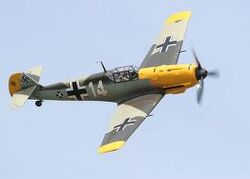| This page is lifted entirely from Wikipedia, and has no in-game information. |
Messerschmitt Bf 109[]
The Messerschmitt Bf 109, sometimes incorrectly called the Me 109 (most often by Allied pilots and aircrew), was a German World War II fighter aircraft designed by Willy Messerschmitt and Robert Lusser during the early to mid-1930s. It was one of the first truly modern fighters of the era, including such features as all-metal monocoque construction, a closed canopy, a retractable landing gear, and was powered by a liquid-cooled, inverted-V12 aero engine.

Bf-109
The Bf 109 first saw operational service during the Spanish Civil War and was still in service at the dawn of the jet age at the end of World War II, during which time it was the backbone of the Luftwaffe's fighter force.
From the end of 1941 the Bf 109 was supplemented by the Focke-Wulf Fw 190.
Originally conceived as an interceptor, later models were developed to fulfill multiple tasks, serving as bomber escort, fighter-bomber, day-, night-, all-weather fighter, ground-attack aircraft, and as reconnaissance aircraft. It was supplied to and operated by several states during World War II, and served with several countries for many years after the war. The Bf 109 was the most produced fighter aircraft in history, with a total of 33,984 airframes produced from 1936 up to April 1945.

Bf-109
The Bf 109 was flown by the three top-scoring German fighter aces of World War II, who claimed 928 victories among them while flying with Jagdgeschwader 52, mainly on the Eastern Front, as well as by Hans-Joachim Marseille, the highest scoring German ace in the North African Campaign,[4] scoring 158 victories. It was also flown by several other aces from Germany's allies, notably Finn Ilmari Juutilainen, the highest scoring non-German ace on the type with 58 victories flying the Bf 109G, and pilots from Italy, Romania, Croatia, Bulgaria and Hungary. Through constant development, the Bf 109 remained competitive with the latest Allied fighter aircraft until the end of the war.
Record-setting flights[]
In July 1937, not long after the public debut of the new fighter, three Bf 109Bs took part in the Flugmeeting airshow in Zürich under the command of Major Seidemann. They won in several categories: First Prize in a speed race over a 202 km course, First Prize in the Class A category in the international Alpenrundflug for military aircraft, and victory in the international Patrouillenflug category.
On 11 November 1937, the Bf 109 V13 flown by Messerschmitt's chief pilot Dr. Hermann Wurster, powered by a 1,230 kW (1,650 hp) DB 601R racing engine, set a new world air speed record for landplanes with piston engines of 610.55 km/h (379.38 mph), winning the title for Germany for the first time. Converted from a Bf 109D, the V13 had been fitted with a special racing DB 601R engine that could deliver 1,230 kW (1,650 hp) for short periods.

Bf-109-Demostration
Heinkel, having had the He 112 rejected in the design competition of 1936, designed and built the He 100. On 6 June 1938, the He 100 V3, flown by Ernst Udet, captured the record with a speed of 634.7 km/h (394.4 mph). On 30 March 1939, test pilot Hans Dieterle surpassed that record, reaching 746.61 km/h (463.92 mph) with the He 100 V8. Messerschmitt, however, soon regained the lead when, on 26 April 1939, Flugkapitän Fritz Wendel, flying the Me 209 V1, set a new record of 755.14 km/h (469.22 mph). For propaganda purposes, the machine was called the Bf 109R, suggesting it was just another variant of the standard fighter, but in fact it was a racing aircraft having little in common with the Bf 109. It was powered by the DB 601ARJ, producing 1,156 kW (1,550 hp), but capable of reaching 1,715 kW (2,300 hp). This world record for a piston-engined aircraft was to stand until 1969, when Darryl Greenamyer's modified Grumman F8F Bearcat, Conquest I, broke it with a 777 km/h (483 mph) record speed.
Specifications (Bf 109 G-6)[]
Data from The Great Book of Fighters and the Finnish Air Force Bf 109 Manual
General characteristics
- Crew: One
- Length: 8.95 m (29 ft 7 in)
- Wingspan: 9.925 m (32 ft 6 in)
- Height: 2.60 m (8 ft 2 in)
- Wing area: 16.05 m² (173.3 ft²)
- Empty weight: 2,247 kg (5,893 lb)
- Loaded weight: 3,148 kg (6,940 lb)
- Max. takeoff weight: 3,400 kg (7,495 lb)
- Powerplant: 1 × Daimler-Benz DB 605A-1 liquid-cooled inverted V12, 1,475 PS (1,455 hp, 1,085 kW)
- Propellers: VDM 9-12087 three-bladed light-alloy propeller
- Propeller diameter: 3 m (9 ft 10 in)
Performance
- Maximum speed: 640 km/h (398 mph) at 6,300 m (20,669 ft)
- Cruise speed: 590 km/h (365 mph) at 6,000 m (19,680 ft)
- Range: 850 km (528 mi) 1,000 km (621 mi) with droptank
- Service ceiling: 12,000 m (39,370 ft)
- Rate of climb: 17.0 m/s (3,345 ft/min)
- Wing loading: 196 kg/m² (40 lb/ft²)
- Power/mass: 344 W/kg (0.21 hp/lb)
Armament
- Guns:
- 2 × 13 mm (.51 in) synchronized MG 131 machine guns with 300 rounds per gun
- 1 × 20 mm MG 151 cannon as Motorkanone with 200 rpg.[75] G-6/U4 variant: 1 × 30 mm (1.18 in) MK 108 cannon as Motorkanone with 65 rpg
- 2 × 20 mm MG 151/20 underwing cannon pods with 135 rpg (optional kit—Rüstsatz VI)
- Rockets: 2 × 21 cm (8 in) Wfr. Gr. 21 rockets (G-6 with BR21)
- Bombs: 1 × 250 kg (551 lb) bomb or 4 × 50 kg (110 lb) bombs or 1 × 300-litre (79 US gal) drop tank
